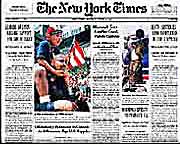
| Fit To Print |
 |
followthemedia.com - a knowledge base for media professionals |
|
|
AGENDA
|
||
“Platform Neutrality” No Longer Means Writing for the Newspaper and Adapting for the Web.
|
| ftm background |
|
Can A Newspaper or Broadcaster’s Web Site Become Too Popular? New York Times Tries Something New: If the Young Won’t Read Its Newspaper, Then Buy Into the One They Do Did You Notice That All Those Big Newspaper Deals This Year to Buy Internet Sites Were for Cash, Not Shares? Who Do You Think Is Raking In the Money? NYT Baits Bloggers |
And it makes clear there is no stopping the digital revolution. The Times has, for instance, various video capabilities it can put to good use on its web platform, and the public have taken up broadband delivery to the point that video is now appealing.
“Our readers are moving on, and so are we,” said a memo signed by Bill Keller, Times executive editor, and Martin Nisenholtz, senior vice president for digital operations.
The Times currently makes all of its production available for its web site, but that means the web is really just a different platform to display the print information. Under the new policy the web gets involved in the early story planning stages and as those stories are worked on the needs for the web are uppermost in thought – different pictures, perhaps different stories, video, and all the rest.
It is yet another transformation for the newspaper website, already profitable and which management believes could be the cash cow for the future. Starting September 19 it will charge $49.95 for a new product, TimesSelect that provides paid -only access to the so-called op-ed writers – eight star Times writers -- plus regular columns written by 14 other staff news columnists. Other benefits include access to the archives which now costs $2.95 an item and earns around $1 million a year. A print edition subscriber gets TimesSelect at no additional charge.
Currently the print and web newsrooms are in different buildings and they won’t fully physically integrate into one newsroom until the Times moves into a new 52-story Times Square headquarters in 2007. But some steps are being taken now.
“We are looking at ways to promote much more side-by-side cooperation in conceiving and executing journalism,” the memo said. “Web producers should routinely participate in the daily conversations where coverage is launched. Senior editors of the Web should be a presence at all of the meetings where …others hatch plans. In the (newspaper) newsroom everyone should come to regard the website as his or her responsibility.”
Under the plan the newspaper managing editor for news becomes also managing editor of news for the web site; the newspaper foreign report editor becomes the foreign report for the web site. It’s convergence in the truest sense.
 The message is very clear. The online component of the Times’ multi-platform information system has been publicly upgraded to being as important as the mother print ship itself. The newspaper is said to have more than 1100 editorial staff whereas the web site has about 40, so in practical terms the message was really to tell print how strategic the company sees its nytimes web operation and as journalists they need to adapt to that thinking, too.
The message is very clear. The online component of the Times’ multi-platform information system has been publicly upgraded to being as important as the mother print ship itself. The newspaper is said to have more than 1100 editorial staff whereas the web site has about 40, so in practical terms the message was really to tell print how strategic the company sees its nytimes web operation and as journalists they need to adapt to that thinking, too.
Barry Lipton, president of the Newspaper Guild of New York, said the union had no philosophical problem with the combining of newsrooms, but since each now works under separate contracts (the 40 web staff are said to earn less than their newspaper compatriots) then negotiations will be necessary to cover pay differentials.
Many newspaper analysts said they thought this was a move whose time had come. But the number of US newspapers that have actually combined their print and web sites are few and far between. Two of the largest and most successful competitors to the Times, TheWashington Post and The Wall Street Journal both maintain separate print-web staffs and neither have indicated they plan to merge them.
Many newspapers have recognized the importance and popularity of their web sites, but since print produces so much more advertising revenue than the web site, there has always been a reluctance to see each as equals. Indeed some newspapers in the past 12 months have started to take items off their web sites so they are available only within the print edition in an effort to regain readers who may have left print entirely for the web site.
On the journalistic side, platform neutrality still meant producing for the newspaper and then adapting that work for the web.
The Times has now made clear that with its web site already seeing more readers than the print edition and with advertising revenues growing at rates much faster than for print, that now is the time to ensure that the web can be the very finest editorial product possible, embracing all that the digital revolution permits to tell a story, encouraging its editorial staff when planning and providing coverage to think digital as it thinks print..
It’s a philosophy other newspapers should closely follow.
| copyright ©2005 ftm publishing, unless otherwise noted | Contact Us • Sponsor ftm |